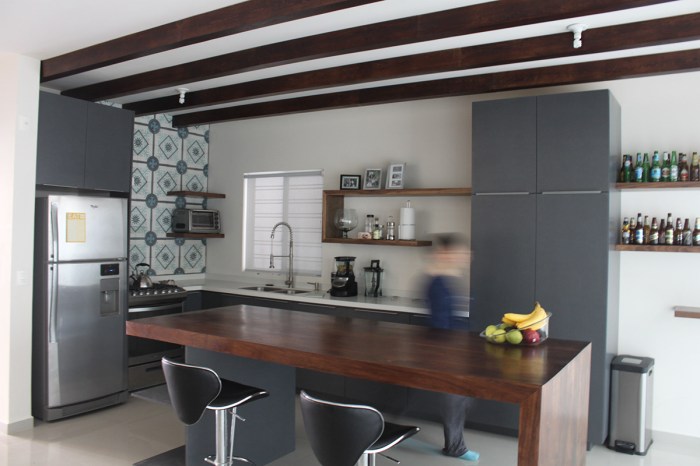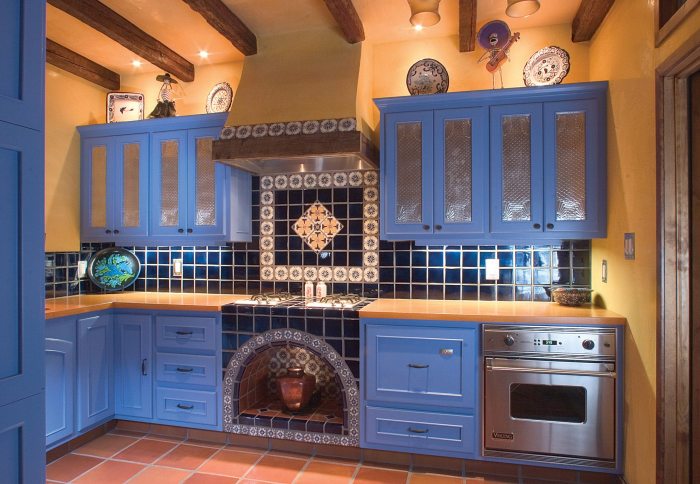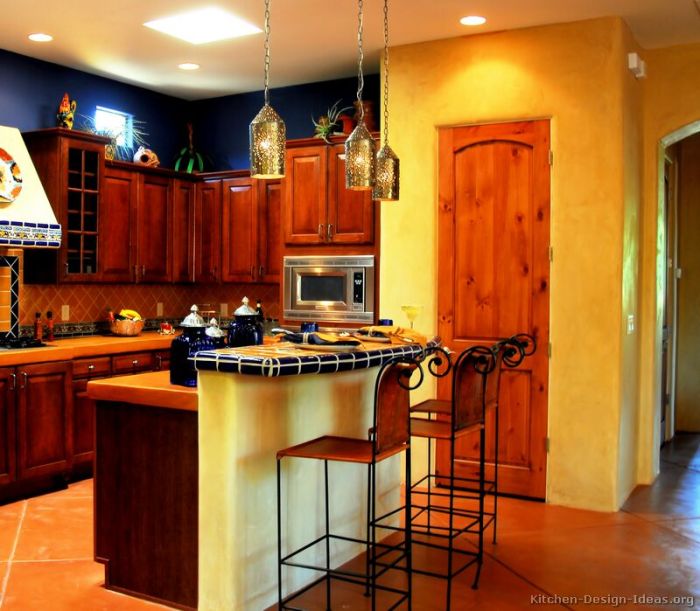Mexican Tilework and Patterns in Kitchen Design

Mexican kitchen decor ideas – Yo, peeps! Let’s spice up your kitchen game with some seriously rad Mexican tile. Forget boring beige – we’re talking vibrant colors, intricate designs, and a whole lotta personality. Think of it as adding a fiesta to your cooking space, Surabaya style!
Types of Mexican Tiles, Mexican kitchen decor ideas
Mexican tiles bring a unique aesthetic to any kitchen. Two popular choices are Talavera and cement tiles, each offering a distinct look and feel. Talavera tiles are known for their hand-painted designs and vibrant colors, often featuring floral motifs, geometric patterns, or even depictions of animals. They’re like miniature works of art, each tile unique. Cement tiles, on the other hand, boast a more matte finish and a wider range of patterns, from simple geometric shapes to complex arabesques.
Thinking of spicing up your kitchen with a vibrant Mexican theme? Remember, the details make all the difference! A great way to add that authentic touch is by creatively styling your shelves; check out these amazing ideas for kitchen shelf decor ideas to inspire you. Then, incorporate colorful pottery, handwoven textiles, and maybe even a miniature sombrero or two to complete your cheerful Mexican kitchen decor.
They often feature a more muted color palette, but can still pack a punch. Think of them as the cool, understated sibling to the vibrant Talavera.
Sample Kitchen Backsplash Layout
Okay, so imagine this: We’re gonna combine Talavera and cement tiles for a killer backsplash. We’ll use a sunny yellow and turquoise Talavera tile as the main focus, arranging them in a staggered pattern for a dynamic look. Then, we’ll use smaller, square cement tiles in a complementary shade of terracotta to create a border around the Talavera tiles and add some visual interest.
The terracotta will ground the brighter Talavera, creating a balanced and stylish look.
| Terracotta | Terracotta | Terracotta | Terracotta |
| Terracotta | Yellow Talavera | Yellow Talavera | Terracotta |
| Terracotta | Turquoise Talavera | Yellow Talavera | Terracotta |
| Terracotta | Yellow Talavera | Turquoise Talavera | Terracotta |
| Terracotta | Terracotta | Terracotta | Terracotta |
This layout creates a visually appealing contrast between the vibrant Talavera and the earthy terracotta, while the staggered pattern prevents monotony. It’s a modern take on traditional Mexican design, perfect for a Surabaya kitchen with a bit of an edge.
Talavera vs. Cement Tiles: Durability, Maintenance, and Cost
Choosing between Talavera and cement tiles depends on your priorities. Talavera tiles, being handcrafted, are generally more expensive. They require more careful cleaning to avoid damaging the hand-painted surface. However, their unique beauty and character make them a worthwhile investment for those who appreciate artisan craftsmanship. Cement tiles, while also beautiful, are typically more affordable and durable, able to withstand heavy traffic and more robust cleaning methods.
They’re easier to maintain, making them a practical choice for busy kitchens. Think of it like this: Talavera is the showstopper, while cement is the reliable friend. Both have their place, depending on your style and budget.
Incorporating Traditional Mexican Furniture: Mexican Kitchen Decor Ideas

Yo, peeps! Let’s spice up that Mexican kitchen design with some seriously rad furniture. Forget IKEA – we’re going full-on authentic here, mixing practicality with that killer Mexican vibe. Think rustic charm meets modern convenience. We’re talking furniture that tells a story, not just sits there looking pretty.
Traditional Mexican Furniture Styles for the Kitchen
Three main styles dominate traditional Mexican kitchen furniture: rustic wood, colorful painted, and wrought iron. Each offers a unique aesthetic and functionality. Rustic wood pieces often boast hand-carved details, showcasing the craftsmanship and natural beauty of the wood. Painted furniture brings in vibrant hues and patterns, adding a playful pop to the space. Wrought iron pieces, often combined with wood or other materials, lend a touch of elegance and durability.
- Rustic Wood: Think sturdy chairs made from dark, rich woods like cedar or pine, possibly featuring simple yet elegant carvings. Tables might have thick, wide legs and a solid, naturally finished tabletop. The construction emphasizes strength and durability, often using traditional joinery techniques. Imagine a breakfast nook with these chairs – super comfy and undeniably stylish.
- Colorful Painted Furniture: This style often features bright, bold colors like reds, yellows, and blues, often with decorative patterns or designs painted directly onto the wood. Benches might be painted in a vibrant floral pattern, while a small table might feature geometric designs. The construction is typically simple, but the paintwork is the star of the show. Think of a colorful painted bench against a terracotta-tiled wall – instant fiesta!
- Wrought Iron: Wrought iron is frequently incorporated into chairs, tables, and even shelving units. It’s known for its strength and elegant curves. Often, wrought iron is combined with other materials like wood or tile to create a more balanced aesthetic. A wrought iron chair with a wooden seat, for example, would be both stylish and surprisingly comfortable. Picture a wrought iron bistro set with a tiled tabletop – super chic!
Creating a Cohesive and Functional Mexican-Style Kitchen
Choosing the right furniture is key to achieving that authentic Mexican kitchen feel. Here’s a list of furniture pieces that strike the perfect balance between style and function:
- A large, sturdy wooden dining table – perfect for family meals and gatherings.
- Matching rustic wooden chairs or colorful painted benches.
- A small, painted wooden side table for drinks and snacks.
- Open shelving made from rustic wood or wrought iron to display colorful ceramics and cookware.
- A comfortable wrought iron and wood kitchen island, possibly with a tiled countertop, to add extra prep space.
Furniture Styles and Color Palette Coordination
The beauty of Mexican design lies in its versatility. Different furniture styles can complement various color palettes and tile designs beautifully.
- Rustic Wood & Earthy Tones: Rustic wood furniture pairs perfectly with earthy tones like terracotta, beige, and olive green. Imagine a kitchen with terracotta tiles, beige walls, and a dark wood dining table. The natural tones create a warm and inviting atmosphere.
- Colorful Painted Furniture & Vibrant Hues: Brightly painted furniture complements vibrant color palettes. Think of a kitchen with blue and yellow tiles, paired with benches painted in complementary shades. The bold colors create a fun and energetic space.
- Wrought Iron & Monochromatic Schemes: Wrought iron furniture can add elegance to a more monochromatic scheme. A kitchen with black and white tiles would look stunning with wrought iron accents, creating a sophisticated contrast.
Lighting and Accessories in a Mexican Kitchen

Yo, peeps! Let’s spice up that Mexican kitchen design with some killer lighting and accessories. Think vibrant colours, handcrafted details – the whole shebang. We’re talking about creating a space that’s totally Instagram-worthy, but also feels authentic and comfy.Lighting is key, you know? It sets the mood, highlights the awesome details, and just generally makes the space pop.
The right lighting can transform a basic kitchen into a fiesta-ready paradise. And accessories? They’re the cherry on top, adding personality and that unique Mexican touch.
Traditional Mexican Lighting Fixtures
Incorporating traditional Mexican lighting fixtures can instantly elevate the ambiance of your kitchen. Wrought iron chandeliers, for example, bring a rustic elegance, their intricate designs casting dramatic shadows and adding a touch of old-world charm. Imagine a chandelier with swirling patterns, maybe some decorative flourishes like leaves or flowers, hanging above your kitchen island. The dark metal contrasts beautifully with lighter walls and brightly colored furniture.
Hand-painted lamps, on the other hand, offer a more playful and vibrant feel. These could feature bold colours and patterns, perhaps depicting scenes from Mexican culture or flora and fauna. A hand-painted lamp with bright sunflowers and hummingbirds would inject a cheerful energy into a corner seating area. The soft glow from the lampshade would create a cozy and inviting atmosphere, perfect for late-night chats.
These lighting choices offer a diverse range of visual styles, allowing for customization to match the overall aesthetic of the kitchen.
Unique Accessories Enhancing Mexican Aesthetics
To truly capture the essence of a Mexican kitchen, thoughtful accessories are essential.
- Hand-painted Pottery: Think vibrant Talavera pottery – bowls, plates, even a stunning pitcher. The intricate designs, often featuring floral motifs or geometric patterns in bright blues, greens, yellows, and oranges, add a pop of color and visual interest. The glazed finish ensures durability and a beautiful sheen.
- Woven Placemats: These add texture and warmth. Look for placemats crafted from natural fibers like sisal or jute, often featuring intricate patterns in earthy tones or bright, bold colours. The natural materials provide a rustic touch that complements the overall design, while the woven patterns add a touch of elegance.
- Colorful Textiles: Think vibrant embroidered table runners, napkins, or even a bold patterned kitchen curtain. These textiles introduce rich textures and colours, reflecting the lively spirit of Mexican culture. The embroidery work itself can be a beautiful display of craftsmanship, adding a personal touch to the space.
- Hand-carved Wooden Cutting Board: A substantial cutting board, possibly with a carved design depicting Mexican imagery like cacti or animals, adds both functionality and visual appeal. The rich grain of the wood and the detailed carving elevate the kitchen’s aesthetic, while the practical use makes it a functional and beautiful piece.
- Metal Canisters for Storage: These can be tin or another metal, often decorated with bright colours and designs, providing both storage and visual appeal. These canisters can hold spices, sugar, flour, or other kitchen staples, adding to the overall design scheme while keeping things organized. The metallic sheen adds a modern touch to the traditional aesthetic.
Highlighting Architectural Details and Furniture with Lighting
Strategic lighting can make all the difference in showcasing the unique features of your Mexican-style kitchen. Recessed lighting can highlight decorative ceiling beams, while strategically placed spotlights can accentuate hand-painted tiles or a beautiful Talavera sink. Under-cabinet lighting can add warmth and functionality to countertops, while pendant lights above the island can create a focal point and illuminate the space.
Using a combination of ambient, task, and accent lighting ensures that all the key architectural details and furniture pieces are properly showcased, creating a well-balanced and visually stunning space.
FAQ Section
What are some budget-friendly ways to incorporate Mexican decor into my kitchen?
Focus on affordable accents like vibrant textiles, hand-painted pottery from local artisans (or ethically sourced online), and repurposed furniture. Consider painting existing cabinets a bold color instead of a full remodel.
How can I maintain the authenticity of a Mexican kitchen design while avoiding clichés?
Research specific regional styles within Mexico to avoid generic stereotypes. Prioritize quality handcrafted pieces over mass-produced imitations, and focus on creating a cohesive narrative through careful material and color selection rather than simply accumulating decorative items.
Are there any modern interpretations of traditional Mexican kitchen elements?
Absolutely. Modern Mexican kitchens often incorporate clean lines and minimalist aesthetics while still utilizing traditional materials like Talavera tiles or incorporating bold color palettes inspired by Mexican art. The key is to blend traditional elements with contemporary design principles for a unique look.
